List of Armenian monarchs and presidents
This list is a list of Armenian monarchs
Antiquity[change | change source]
| No. | Name | Years | Portrait or couinage | Notes | House |
|---|---|---|---|---|---|
| 1 | Orontes III | 321–260 BC | –
|
|
Orontid |
| 2 | Sames I | 260–243 BC | 
|
| |
| 3 | Arsames I | 243–228 BC | 
|
| |
| 4 | Xerxes I | 228–212 BC | 
|
| |
| 5 | Orontes IV | 212–200 BC | 
|
| |
| 6 | Artaxias I | 189–160 BC | 
|
|
Artaxiad |
| 7 | Artavasdes I | 160 BC–115 BC | 
|
| |
| 8 | Tigranes I | 120–95 BC(?) | 
|
| |
| 9 | Tigranes II the Great | 95–55 BC[1] | 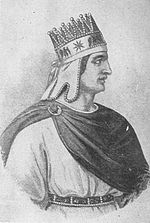
|
| |
| 10 | Artavasdes II | 55–34 BC | 
|
| |
| 11 | Artaxias II | 34 BC–20 BC | 
|
| |
| 12 | Tigranes III | 20 BC–8 BC | 
| ||
| 13 | Erato | 8 BC–2 AD | 
|
| |
| Tigranes IV | 
| ||||
| 14 | Ariobarzanes II | 2–4 | –
|
|
–
|
| 15 | Artavasdes IV | 4–6 | –
| ||
| 16 | Erato | 6–12 | 
|
|
Artaxiad |
| Tigranes V | –
|
–
| |||
| 17 | Vovones I | 12–18 | 
|
|
Arsacid |
| 18 | Artaxias III | 18–34 | 
|
–
|
–
|
| 19 | Arsaces I | 34–35 | –
|
|
Arsacid |
| 20 | Orodes I | 35–35 | –
|
|
Arsacid |
| 21 | Mithridates I | 35–37 | –
|
|
–
|
| 22 | Orodes I | 37–42 | –
|
|
Arsacid |
| 23 | Mithridates I | 42–51 | –
|
|
–
|
| 24 | Rhadamistus | 51–53 | 
|
|
–
|
| 25 | Tiridates I | 53–53 | 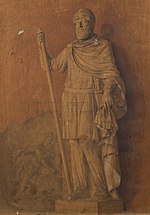
|
|
Arsacid |
| 26 | Rhadamistus | 54–55 | 
|
|
–
|
| 27 | Tiridates I | 55–88 | 
|
|
Arsacid |
| 28 | Sanatruk I | 88–110 | –
|
| |
| 29 | Axidares I | 110–113 | –
|
| |
| 30 | Parthamasiris I | 113–114 | –
| ||
| 31 | Vologases I | 118–140 | –
|
|
Arsacid |
| 32 | Sohaemus | 141–161 | 
|
|
–
|
| 33 | Bakur I | 161–163 | –
|
|
Arsacid |
| 34 | Sohaemus | 163–180 | 
|
|
–
|
| 35 | Vologases II | 180–191 | 
|
|
Arsacid |
| 36 | Khosrov I | 191–217 | –
|
| |
| 37 | Tiridates II | 217–252 | –
|
| |
| 38 | Hormizd-Ardashir | 252–270 | 
|
|
–
|
| 39 | Narseh | 270–280 | 
|
|
–
|
| 40 | 280–287 | ||||
| Khosrov II | 280–287 | 
|
|
Arsacid | |
| 41 | Narseh | 287–293 | 
|
–
|
–
|
| Tiridates (III) | 287–293 | –
|
|
Arsacid | |
| 42 | 293–298 | ||||
| 43 | Tiridates III (or IV) | 298–330 | 
|
| |
| 44 | Khosrov III | 330–339 | –
|
| |
| 45 | Tigranes VII | 339–350 | –
|
| |
| 46 | Arshak II | 350–368 | –
|
| |
| 47 | Pap | 370–375 | 
|
| |
| 48 | Varazdat I | 375–378 | 
|
| |
| The Sasanians appointed their own Armenian king (Khosrov IV) in 384, against the Roman-supported Arshak III, leading Armenia to becoming informally divided under the two kings. Upon the death of the Roman-supported Arshak III in 389, Emperor Theodosius I, unable to appoint another king, incorporated the region into the Roman Empire. Thus, the Sasanian-supported kings became the sole kings of Armenia. | |||||
| 49 | Vramshapuh | 389–414 | 
|
| |
| 50 | Shapur | 418–422 | –
|
|
–
|
| 51 | Artaxias IV | 422–428[3] | –
|
|
Arsacid |
Medieval[change | change source]
Non-independent rulers of Armenia[change | change source]
The rulers of Armenia under the Sasanians (as province, known as the Persarmenia), Rashidun, Umayyad and Abbasid (as autonomous, known as the Arminiya) caliphates.
Bagratid Kingdom of Armenia[change | change source]
The Bagratid Armenia was an independent Armenian state established by Ashot I Bagratuni of the Bagratuni dynasty in the early 880s following nearly two centuries of foreign domination of Greater Armenia under Arab Umayyad and Abbasid rule.
Bagratid Kingdom of Armenia
| |||||
|---|---|---|---|---|---|
| No. | Name | Years | Portrait or couinage | House | Notes |
| 1 | Ashot I the Great | 884[4]–890 | 
|
Bagratuni |
|
| 2 | Smbat I | 890–914[4] | –
|
| |
| 3 | Ashot II | 914–928 | 
|
| |
| 4 | Abas I | 928–952[4] | –
| ||
| 5 | Ashot III the Merciful | 953–977 | 
|
| |
| 6 | Smbat II | 977–989[5] | 
|
| |
| 7 | Gagik I | 989–1020[5] | 
| ||
| 8 | Hovhannes-Smbat III | 1020–1040 | –
|
| |
| Ashot IV | 1021–1039 | –
|
| ||
| 9 | Gagik II | 1041–1045[6] | –
|
| |
Variorous Armenian kingdoms[change | change source]
Kingdom of Kars (962/3–1064)
- Mushegh (962/3[5]–984) son of Abas I of Armenia
- Abas I (984–1029)
- Gagik-Abas II (1029–1064) he claimed the position of king of all Armenia following the collapse of the main Bagratid kingdom in 1045.
The kingdom centered on now northeastern Turkey (Kars Province) and northwestern Armenia.
Kingdom of Vaspurakan (908–1021)

- Gagik I Ardsruni (908–943[4])
- Derenik-Ashot Adrsruni (943–958[5])
- Abusahl-Hamazasp (958–968[5])
- Ashot-Sahak (969/972–991)
- Gurgen-Khachik (991–1003)
- Seneqerim-Hovhannes (1003–1021)
The kingdom centered on Lake Van, located in what is now eastern Turkey (in Van Province) and partially northwestern Iran.
Kingdom of Syunik (970–1170)
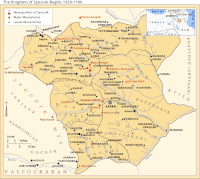
- Smbat II (970–998[5])
- Vasak VI (998–1019[5])
- Smbat III (1019–1044)
- Grigor I (1044–1084)
- Senekerim Sevadian (1084–1094)
- Grigor II (1094–1166)
- Hasan of Gerakar (1166–1170) son-in-law of Grigor II
The kingdom centered in Syunik province of now Armenia.
Kingdom of Lori (982–1145)

- Gurgen I (982[5]–989)
- David I (989–1046/1048)
- Gurgen II (1046/1048–1081/1089)
- David II and Abas (1089–1145)
The kingdom was located on the territories of modern-day northern Armenia, partially northwestern Azerbaijan and southern Georgia.

In addition, five Armenian meliks ruled the mountainous Karabakh from the 14th to the 19th centuries.
Armenian Kingdom of Cilicia[change | change source]
The Armenian Kingdom (starting of an principality) of Cilicia was an Armenian state formed during the High Middle Ages by Armenian refugees fleeing the Turcoman invasion of the Armenia. Located outside the Armenian Highlands and distinct from the Kingdom of Armenia of antiquity or medieval.
Armenian Principality of Cilicia
(1080–1198) | |||||
|---|---|---|---|---|---|
| No. | Prince | Years | Portrait or couinage | Notes | House |
| 1 | Ruben I | 1080–1095 | 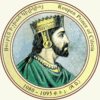
|
|
Rubenid |
| 2 | Constantine I | 1095–1099 | 
|
| |
| 3 | Thoros I | 1100/2–1129[7] | –
|
| |
| 4 | Leo I | 1129[7]–1138 | 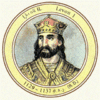
| ||
| 5 | Thoros II the Great | 1145–1169 | –
|
| |
| 6 | Ruben II | 1169–1170 | –
|
| |
| 7 | Mleh I | 1170–1175 | –
|
| |
| 8 | Ruben III | 1175–1186/7[8] | –
|
| |
| 9 | Leo II | 1186/7[8]–1198 | 
| ||
Armenian Kingdom of Cilicia (1198–1375)
| |||||
| No. | King | Years | Portrait or couinage | Notes | House |
| (9) | Leo I (II) | 1199–1219 | 
|
|
Rubenid |
| 10 | Isabella | 1219–1226 | 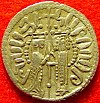
|
| |
| 11 | 1226–1253 | ||||
| Hethum I | 1226–1253 | 
|
|
Hethumid | |
| 12 | 1253–1270 | ||||
| 13 | Leo II (III) | 1268–1289[9] | 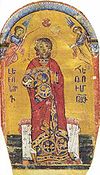
|
| |
| 14 | Hethum II | 1289–1293 | 
|
| |
| 15 | Thoros III | 1293–1294 | –
|
| |
| 16 | Hethum II | 1294–1296 | 
|
| |
| 17 | Smbat IV | 1296–1298 | 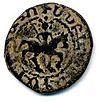
|
| |
| 18 | Constantine I (II) | 1298–1299 | 
| ||
| 19 | Hethum II | 1299–1305 | 
|
| |
| 20 | Leo III (IV) | 1305–1308 | –
|
| |
| 21 | Oshin | 1308–1320 | 
|
| |
| 22 | Leo IV (V) | 1320–1341[10] | 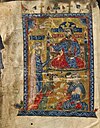
|
| |
| 23 | Constantine II (IV) | 1342–1344 | 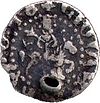
|
|
Lusignan |
| 24 | Constantine III (V) | 1344–1362 | 
|
|
Hethumid–Lusignan |
| 25 | Constantine IV (VI) | 1362–1373 | –
|
–
|
Hethumid |
| 26 | Leo V (VI) | 1374–1375[11] | 
|
|
Lusignan |
Turcoman kings of Armenia[change | change source]
In the decades following the Battle of Manzikert, one of the Turcoman vassal dynasties of the Seljuk Turks gained control of the city of Ahlat in the former Armenian heartland. These Turcoman emirs took the used title of Shah-i Armen (ie. "King of the Armenians").
| No. | Name | Years | Portrait or couinage | House | Notes |
|---|---|---|---|---|---|
| 1 | Sökmen | 1100–1111 | –
|
Sökmenid |
|
| 2 | Zahireddin Ibrahim | 1111–1127 | –
|
–
| |
| 3 | Ahmed | 1127 | –
|
–
| |
| 4 | Sökmen II | 1128–1185 | –
|
–
|
Qara Qoyunlu[change | change source]
The title Shah-i Armen was temporarily revived in the 15th century under the rule of the Turcoman Qara Qoyunlu during the rule of Qara Iskandar.
Iskandar sought to cultivate the Armenian population, especially the feudal lords and clergy. To reinforce this policy, he took the title "Shah-i Armen," King of the Armenians.[12]
| No. | Name | Years | Portrait or couinage | House | Notes |
|---|---|---|---|---|---|
| 1 | Iskandar[12] or Qara Iskandar | 1420–1436 | 
|
Qara Qoyunlu |
|
References[change | change source]
- ↑ Adalian 2010, p. xxix.
- ↑ Lang 1983, p. 516.
- ↑ Adalian 2010, p. xxxiii.
- ↑ 4.0 4.1 4.2 4.3 Adalian 2010, p. xxxvi.
- ↑ 5.0 5.1 5.2 5.3 5.4 5.5 5.6 5.7 Adalian 2010, p. xxxvii.
- ↑ Adalian 2010, p. xxxviii.
- ↑ 7.0 7.1 Adalian 2010, p. xxxix.
- ↑ 8.0 8.1 Adalian 2010, p. xi.
- ↑ Adalian 2010, p. xli.
- ↑ Adalian 2010, p. xlli.
- ↑ Adalian 2010, p. xlii.
- ↑ 12.0 12.1 Kouymjian 1997, p. 5.
Sources[change | change source]
- Lang, David M. (1983). "Iran, Armenia and Georgia". In Yarshater, Ehsan (ed.). The Cambridge History of Iran, Volume 3: The Seleucid, Parthian and Sasanid Periods. Cambridge University Press. p. 516. ISBN 0-521-20092-X.
- Adalian, Rouben Paul (2010). Historical Dictionary of Armenia. Scarecrow Press. ISBN 978-0-8108-7450-3.
- Kouymjian, Dickran (1997). "Armenia from the Fall of the Cilician Kingdom (1375) to the Forced Emigration under Shah Abbas (1604)". In Hovannisian, Richard G. (ed.). The Armenian People From Ancient to Modern Times: Foreign Dominion to Statehood: The Fifteenth Century to the Twentieth Century. Vol. 2. New York: St. Martin Press. ISBN 9780312101688.

